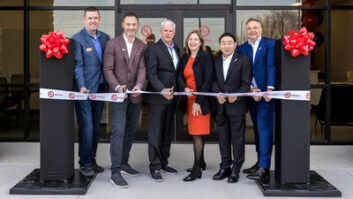NEW YORK —
OE-look factory-fit radios fit nonstandard
dash openings in specific vehicle models
and look like they came from the factory. The radios
plug into factory wiring harnesses without additional
harness adapters, and many
plug into OEM databus systems
to ensure that other
factory electronics, such as
OnStar, continue to work as
designed.
But are factory-fit radios a
good fit for the retail channel?
In recent years, suppliers
reintroduced OE-look radios to the expediter channel,
and now some retailers want to sell the products
through their retail storefronts. The dealers believe
they can expand their potential customer base by appealing
to a greater number of used-car and new-car
buyers.
Among used-car buyers, retailers could tap demand
for factory-look radios that deliver features — such as
touchscreens, Bluetooth and iPod control — that used
to be rare in factory radios. In the new-car market, retailers
believe they can reach cost-conscious new-car
buyers who don’t want to spend thousands of dollars
for an option package just to get the premium sound
system or navigation that they like.
In both segments, dealers
could upgrade customers
from a CD system to a
multimedia-navigation system.
The opportunity for OE look
radios at retail has
grown in both the new-car
and used-car segments because
of consumer’s newfound
frugality, marketers and retailers said. Used-car
sales have soared during recent tough economic times
because more consumers have opted to save money
by buying previously leased vehicles. Although newcar
sales have surged as well in the past year, new-car
buyers don’t always want to pay for an expensive options
package just to get the one or two options that
they really want, they added.
In both segments, OE-look radios would also
appeal to consumers displeased with the cosmetic
look of a standard single-DIN or double-
DIN radio fitted into an unusually shaped factory
opening with the help of an install kit. OE-look
radios would also appeal to consumers who
want to replace a factory radio that’s integrated
with a vehicle’s databus but don’t want to lose
the functionality of such factory systems as On-
Star, door chimes that sound through the factory
speakers, and the like.
Databus integration is also needed in select
vehicles to ensure the outboard factory amplifier
turns on when the radio is turned on, and in
some vehicles, to ensure the check-engine light
doesn’t remain lit when the OE radio is no longer
in the dash.
OE-look radios resolve such installation issues
because they fit directly into unusually
shaped openings, adopt factory colors and
styling cues, and, depending on the vehicle, incorporate
databus adapters. Some also feature
steering-wheel control interfaces, making it unnecessary
to install a separate adapter.
Key issues for retailers, however, include
the choice of displaying and inventorying head
units that fit a handful of vehicles rather than
hundreds of vehicles, whether the radios can
be merchandised effectively by displaying and
inventorying only a model or two, and whether
dealers need only display one SKU and use literature
and other marketing materials to sell the
others.
Inventory will be a challenge for retailers, said
Audiovox Electronics president Tom Malone,
whose company is expanding its selection of
factory-look radios this year for the expediter
channel.
“Expediters can target specific car models”
because they supply car dealers that sell only
specific vehicle brands, he explained. “How
many GM radios does [a retailer] stock?” Selling
OE-look radios to retailers “requires unique
programs,” he concluded
Although independent dealers and retail
chains have asked Audiovox for OE-look products,
Malone is cautious. “We need to look very
closely to see if that business is manageable,”
he said.
Nonetheless, “retailers see this as a brand
new category,” Malone continued. “Retailers have shown
a surprising level of interest in our OE-look radios that
we’ve not seen before.” The retailers are open to nontraditional
products, seeing them as “an opportunity to upgrade
consumers to a factory-fit radio with the bells and
whistles of aftermarket radios,” he explained.
At last year’s SEMA show, Rosen Entertainment Systems
also noticed retailer interest, although before that,
Rosen began selling OE-look radios through Crutchfield’s
on-line store shortly after entering the OE-look market two
and a half years ago, said sales and marketing VP Steve
Weimar. Some expediters who operate retail stores also
merchandise Rosen’s OE-look multimedia-navigation radios
on their salesfloors, he added.
Rosen’s focus remains primarily on the expediter channel,
but Weimar agrees some opportunity exists for retailers
because an OE-look radio would appeal to “consumers
looking for a more finished look.”
Dealers would be hard-pressed, he agreed, to inventory
and display multiple models of vehicle-specific radios
that fit only a very narrow range of vehicles.
Weimar, however, sees some potential solutions. For
one thing, a dealer who knows his customers might need
only put a couple of vehicle-specific head units on a demo
board and show pictures and provide literature for radios
that fit other vehicles. Because all of Rosen’s OE-look radios
are multimedia-navigation units that provide the same
functionality and user interface from one SKU to the other,
dealers could demo a Honda Civic radio to a Mazda owner,
he contended.
Inventory might not pose much of a challenge either,
Weimar continued, because retailers could do what
Rosen’s expediter customers do: buy on an as-need
basis. Rosen, he noted, offers just-in-time order fulfillment
with same-day shipping. Retailers could also turn
to dealers who supply expediters for their factory-fit radios, he noted.
Chris Cook, executive director of the Mobile Electronics
Retailers Association (MERA), agreed that OE-look radios
present an opportunity for aftermarket retailers.
Expediters who have retail stores, Cook noted, often put
only one OE-look radio in their demo board, and that radio
might fit in multiple vehicles from one automaker, Cook explained.
For other vehicles, the dealers whip out a fit guide.
The biggest potential is in the used-car market, Cook
said. Forty to 44 million used cars are sold per year, or
four times that of new-car sales, he noted. Nonetheless,
new-car owners are also a target. “You can get a reasonably
priced upgrade to a navigation system at a fourth of
the cost of paying $2,500 to $4,000 for an options package
that includes navigation,” he explained.
Like Cook, Robert Elliott, executive director of the In
Car Experts (ICE) buying group, also sees potential, at
least in cases in which a dealer can’t get an aftermarket
radio to fit properly. “It’s something they could embrace
when there is no other choice,” he said.
For independent specialty retailers, however, there is
a downside to widespread adoption of OE-look radios
in the retail aftermarket. “If it’s a direct swap and plug-in,
why seek out an expert installer?” he asked. Such installs
“have no real technical requirements.”
In addition, he said, OE-look suppliers “are not necessarily
companies know for class-leading in-dash navigation
radios,” so performance-oriented specialists might be
less inclined to offer them.













